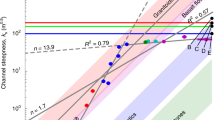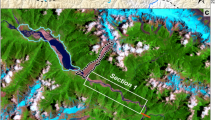Abstract
Valley morphologies of rivers crossing zones of active uplift range from narrow canyons to broad alluvial surfaces. They provide illuminating examples of the fundamental, but poorly understood, competition between relief creation and landscape flattening. Motivated by a field example of abandoned kilometre-wide, fluvially eroded platforms on active detachment folds in the Tian Shan foreland, we present physical experiments investigating the controls on the area of a growing fold that is reworked by antecedent rivers. These experiments reproduce the range of observed field morphologies, varying from wholesale bevelling of the uplifting fold to the formation of narrow, steep-walled canyons. A log-linear fit to a simple dimensionless parameter shows that the competition between lateral channel mobility and rock-uplift rate explains >95% of the variance in the bevelled fraction of the folds. Our data suggest that lateral bedrock erosion rates of 0.5–40 m yr−1 are required to explain the formation of extensive platforms in the Tian Shan foreland and imply that varying water and sediment fluxes can cause striking changes in the degree of landscape flattening by influencing the lateral erosion rate.
This is a preview of subscription content, access via your institution
Access options
Subscribe to this journal
Receive 12 print issues and online access
$259.00 per year
only $21.58 per issue
Buy this article
- Purchase on Springer Link
- Instant access to full article PDF
Prices may be subject to local taxes which are calculated during checkout






Similar content being viewed by others
References
Amos, C. B. & Burbank, D. W. Channel width response to differential uplift. J. Geophys. Res. 112, F02010 (2007).
Duvall, A., Kirby, E. & Burbank, D. Tectonic and lithologic controls on bedrock channel profiles and processes in coastal California. J. Geophys. Res. 109, F03002 (2004).
Harbor, D. J. Dynamic equilibrium between an active uplift and the Sevier River, Utah. J. Geol. 106, 181–194 (1998).
Lavé, J. & Avouac, J. P. Fluvial incision and tectonic uplift across the Himalayas of central Nepal. J. Geophys. Res. 106, 26561–26591 (2001).
Whittaker, A. C. et al. Bedrock channel adjustment to tectonic forcing: implications for predicting river incision rates. Geology 35, 103–106 (2007).
Scharer, K. M., Burbank, D. W., Chen, J. & Weldon, R. J. Kinematic models of fluvial terraces over active detachment folds: constraints on the growth mechanism of the Kashi-Atushi fold system, Chinese Tian Shan. Geol. Soc. Am. Bull. 118, 1006–1021 (2006).
Chen, J. et al. Quantification of growth and lateral propagation of the Kashi anticline, southwest Chinese Tian Shan. J. Geophys. Res. 112, B03S16 (2007).
Heermance, R. V., Chen, J., Burbank, D. W. & Miao, J. Temporal constraints and pulsed Late Cenozoic deformation during the structural disruption of the active Kashi foreland, northwest China. Tectonics 27, TC6012 (2008).
Li, T. et al. Quantification of three-dimensional folding using fluvial terraces: a case study from the Mushi anticline, northern margin of the Chinese Pamir. J. Geophys. Res. 118, 4628–4647 (2013).
Scharer, K. M. et al. Detachment folding in the Southwestern Tian Shan–Tarim foreland, China: shortening estimates and rates. J. Struct. Geol. 26, 2119–2137 (2004).
Heermance, R. V., Chen, J., Burbank, D. W. & Wang, C. Chronology and tectonic controls of Late Tertiary deposition in the southwestern Tian Shan foreland, NW China. Basin Res. 19, 599–632 (2007).
Cook, K. L., Turowski, J. M. & Hovius, N. River gorge eradication by downstream sweep erosion. Nature Geosci. 7, 682–686 (2014).
Johnson, K. N. & Finnegan, N. J. A lithologic control on active meandering in bedrock channels. Geol. Soc. Am. Bull. 127, 1766–1776 (2015).
Paola, C., Straub, K., Mohrig, D. & Reinhardt, L. The ‘unreasonable effectiveness’ of stratigraphic and geomorphic experiments. Earth Sci. Rev. 97, 1–43 (2009).
Douglass, J. & Schmeeckle, M. Analogue modeling of transverse drainage mechanisms. Geomorphology 84, 22–43 (2007).
Ouchi, S. Response of alluvial rivers to slow active tectonic movement. Geol. Soc. Am. Bull. 96, 504–515 (1985).
Pazzaglia, F. J. & Gardner, T. W. Fluvial terraces of the lower Susquehanna River. Geomorphology 8, 83–113 (1993).
Castillo, M., Bishop, P. & Jansen, J. D. Knickpoint retreat and transient bedrock channel morphology triggered by base-level fall in small bedrock river catchments: the case of the Isle of Jura, Scotland. Geomorphology 180, 1–9 (2013).
Finnegan, N. J. & Balco, G. Sediment supply, base level, braiding, and bedrock river terrace formation: Arroyo Seco, California, USA. Geol. Soc. Am. Bull. 125, 1114–1124 (2013).
Bull, W. B. Stream-terrace genesis: implications for soil development. Geomorphology 3, 351–367 (1990).
Hancock, G. S. & Anderson, R. S. Numerical modeling of fluvial strath-terrace formation in response to oscillating climate. Geol. Soc. Am. Bull. 114, 1131–1142 (2002).
Molnar, P. et al. Quaternary climate change and the formation of river terraces across growing anticlines on the north flank of the Tien Shan, China. J. Geol. 102, 583–602 (1994).
Fuller, T. K., Perg, L. A., Willenbring, J. K. & Lepper, K. Field evidence for climate-driven changes in sediment supply leading to strath terrace formation. Geology 37, 467–470 (2009).
DeVecchio, D. E., Heermance, R. V., Fuchs, M. & Owen, L. A. Climate-controlled landscape evolution in the Western Transverse Ranges, California: insights from Quaternary geochronology of the Saugus Formation and strath terrace flights. Lithosphere 4, 110–130 (2012).
Fuller, T. K., Gran, K. B., Sklar, L. S. & Paola, C. Lateral erosion in an experimental bedrock channel: the influence of bed roughness on erosion by bed-load impacts. J. Geophys. Res. 121, 1084–1105 (2016).
Limaye, A. B. S. & Lamb, M. P. Numerical model predictions of autogenic fluvial terraces and comparison to climate change expectations. J. Geophys. Res. 121, 512–544 (2016).
Cazanacli, D., Paola, C. & Parker, G. Experimental steep, braided flow: application to flooding risk on fans. J. Hydrol. Eng. 128, 322–330 (2002).
Kim, W., Sheets, B. A. & Paola, C. Steering of experimental channels by lateral basin tilting. Basin Res. 22, 286–301 (2010).
Wickert, A. D. et al. River channel lateral mobility: metrics, time scales, and controls. J. Geophys. Res. 118, 396–412 (2013).
Constantine, J. A. et al. Sediment supply as a driver of river meandering and floodplain evolution in the Amazon Basin. Nature Geosci. 7, 899–903 (2014).
Whipple, K., Parker, G., Paola, C. & Mohrig, D. Channel dynamics, sediment transport, and the slope of alluvial fans: experimental study. J. Geol. 106, 677–694 (1998).
Parker, G., Paola, C., Whipple, K. & Mohrig, D. Alluvial fans formed by channelized fluvial and sheet flow. I: theory. J. Hydrol. Eng. 124, 985–995 (1998).
Metivier, F. & Meunier, P. Input and output mass flux correlations in an experimental braided stream. Implications on the dynamics of bed load transport. J. Hydrol. 271, 22–38 (2003).
Kim, W., Petter, A., Straub, K. & Mohrig, D. in From Depositional Systems to Sedimentary Successions on the Norwegian Continental Margin (eds Martinius, A. W., Ravnas, R., Howell, J. A., Steel, R. J. & Wonham, J. P.) 127–138 (John Wiley Sons, 2014).
Finnegan, N. J. & Dietrich, W. E. Episodic bedrock strath terrace formation due to meander migration and cutoff. Geology 39, 143–146 (2011).
Sklar, L. S. & Dietrich, W. E. A mechanistic model for river incision into bedrock by saltating bed load. Wat. Resour. Res. 40, W06301 (2004).
Jerolmack, D. J. & Mohrig, D. Conditions for branching in depositional rivers. Geology 35, 463–466 (2007).
Yang, X. & Scuderi, L. A. Hydrological and climatic changes in deserts of China since the late Pleistocene. Quater. Res. 73, 1–9 (2010).
Li, T. et al. Equivalency of geologic and geodetic rates in contractional orogens: new insights from the Pamir Frontal Thrust. Geophys. Res. Lett. 39, L15305 (2012).
Bufe, A., Paola, C. & Burbank, D. W. Fold Erosion by an Antecedent River (SEAD, 2016); http://dx.doi.org/10.5967/M0CF9N3H
Acknowledgements
We acknowledge the help of R. Christopher, J. Mullin, B. Erickson, S. Mielke, E. Steen, P. Pham, L. Horsager, K. Flemming, A. Poovey, E. Zanella and M. Barros with the set-up of the experiments. The work benefited greatly from discussions with J.-L. Grimaud, A. Friedrich, K. Cook, K. Sweeney, A. Wickert, J. Turowski and M. Lamb. J. P. Avouac is thanked for thoughtful comments on the first version of the manuscript. Support from National Science Foundation grant 1050070 to D.W.B. and a UCSB Graduate Student Opportunity award to A.B. is gratefully acknowledged. The project was also supported by the National Science Foundation via the National Center for Earth-surface Dynamics (NCED) under grant EAR-1246761.
Author information
Authors and Affiliations
Contributions
A.B. performed the experiments and data analysis. All authors contributed to the conception of the study and the writing of the manuscript.
Corresponding author
Ethics declarations
Competing interests
The authors declare no competing financial interests.
Supplementary information
Supplementary Information
Supplementary Information (PDF 1988 kb)
Rights and permissions
About this article
Cite this article
Bufe, A., Paola, C. & Burbank, D. Fluvial bevelling of topography controlled by lateral channel mobility and uplift rate. Nature Geosci 9, 706–710 (2016). https://doi.org/10.1038/ngeo2773
Received:
Accepted:
Published:
Issue Date:
DOI: https://doi.org/10.1038/ngeo2773
This article is cited by
-
The shaping of erosional landscapes by internal dynamics
Nature Reviews Earth & Environment (2020)



